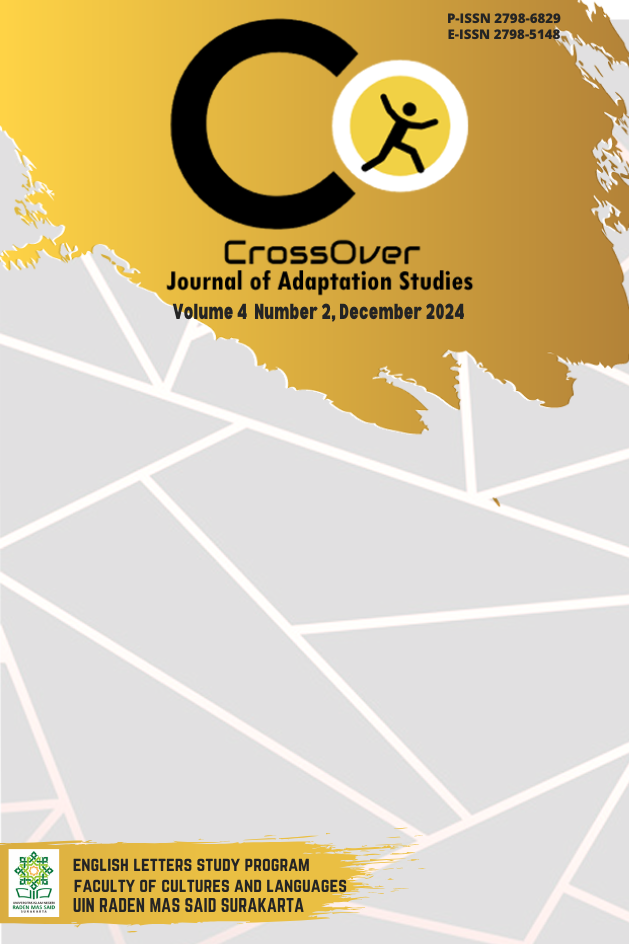I'LL NO LONGER BE A CAPULET: ARCHETYPAL SHIFTS IN THE MOVIE AND ANIME ADAPTATIONS OF SHAKESPEARE'S JULIET
DOI:
https://doi.org/10.22515/crossover.v4i2.10930Keywords:
Adaptation, comparative analysis , structuralism, archetypal characters, Romeo and Juliet.Abstract
Adaptation is being a striking phenomenon that attracts many people because it tends to produce a different sensation of the source text. This research considers this phenomenon in order to reveal the shifts between the source text and the adaptation versions. The article is a comparative study that applies the archetypal theory. It sets out to reveal the similarities and differences with respect to the archetypes pertaining to the Juliet character in Shakespeare’s play, Romeo and Juliet, and its film and anime adaptations. The descriptive qualitative method is used to enable the researcher to do the interpretation and descriptive analysis. Moreover, the research uses the theory of structuralism and archetypal characters by Mark and Pearson. The theory of archetypal character draws from twelve primary archetypes to find and analyze the data through some dialogues and passages of the story. The archetype shifts in Juliet's character are identified by comparing three texts, including William Shakespeare’s Romeo and Juliet (second quarto version), Baz Luhrman’s Romeo + Juliet (1996), and Fumitoshi Oizaki’s Romeo x Juliet (2007). It is discovered that the archetypal character of Juliet shifts in the three analyzed texts. Based on the function of the character, the archetype of Juliet the Lover is maintained in Luhrmann’s Romeo + Juliet. Nonetheless, in Oizaki’s Romeo x Juliet, it changes into Juliet the Hero.
Downloads
References
Bloom, H. (2009). Bloom’s modern critical interpretations: William Shakespeare’s Romeo and Juliet. Bloom’s Literary Criticism.
Bruckner, P. (2023). Analysis of film adaptations of William Shakespeare’s Romeo and Juliet. Univerzita Jana Evangelisty Purkyně.
Cavallaro, D. (2010). Anime and the art of adaptation: Eight famous works from pages to screen. McFarland & Company.
Gagarin, S., & Ambarwati, R. (2021). Archetypal analysis in characters as seen in A Christmas Carol short story. PustakaIlmu.id, 1(2), 1–10.
Guerin, W. L., Labor, E., Morgan, L., Reesman, J. C., & Willingham, J. R. (1979). A handbook of critical approaches to literature (2nd ed.). Oxford University Press.
Hart, C. (2008). Mangamania Shounen: Drawing action-style Japanese comics. Christ Hart Books.
Eagleton, T. (2008). Literary theory: An introduction (Anniversary Edition). The University of Minnesota Press.
Eder, J., Jannidis, F., & Schneider, R. (Eds.). (2010). Characters in fictional worlds: Understanding imagery beings in literature, film, and other media. De Gruyter.
Hundsness, D. (Ed.). (2004). Romeo and Juliet by William Shakespeare. Hundsness. Retrieved from www.hundsness.com
Hutcheon, L. (2006). A theory of adaptation. Routledge.
Jost, F. (1974). Introduction to comparative literature. The Bobbs-Merrill Company Inc.
Katawazai, R. (2018). A critical analysis of William Shakespeare’s Romeo and Juliet. International Journal of Scientific and Research Publications, 8(10). http://dx.doi.org/10.29322/IJSRP.8.10.2018.p8235
Lehmann, C. (2010). Screen adaptation: Shakespeare’s Romeo and Juliet; The relationship between text and film. Bloomsbury.
Lipson, G., & Lipson, S. (2007). Romeo and Juliet, plainspoken: A speech-by-speech modern translation. TLC Company.
Loder, C. (2013). Shakespeare’s Romeo and Juliet: Theatricality of reality against true love? Testi e Linguaggi, 7.
Mandal, P. (2021). Negotiating text and film: Comparative study between Shakespeare’s Romeo and Juliet (1597) and Sanjay Leela Bhansali’s Ram Leela (2013). Interface: Bankura University Journal of Interdisciplinary Research, 1(1), 65–73.
Mark, M., & Pearson, C. (2001). The hero and the outlaw. McGraw-Hill.
McFarlane, B. (1996). Novel to film: An introduction to the theory of adaptation. Clarendon Press.
Nachbar, J., & Lause, K. (1992). Popular culture: An introductory text. Bowling Green State University Press.
Ratcliff, A. (n.d.). Shakespeare’s Romeo and Juliet. Thomas Nelson and Sons, Ltd.
Sahin, I. (2017). Reflections from a collectivist culture: A qualitative analysis on archetypal characters. International Journal of Innovative Research & Development, 6(5), 147–154. http://dx.doi.org/10.24940/ijird/2017/v6/i5/MAY17048
Saputra, W., Karimah, A., & Zaidi, A. (2023). Transmutations of plot and characters: The animated film The Lion King (1994) to the live-action The Lion King (2019). CrossOver: Journal of Adaptation Studies, 3(2), 136–148. https://doi.org/10.22515/crossover.v3i2.7016
Stefanus, B., Sili, S., & Nasrullah. (2020). Archetypal characters in Beautiful Boxer and White Chicks films. Ilmu Budaya: Jurnal Bahasa, Sastra, Seni, dan Budaya, 4(1), 145–157.
Sugiyono. (2019). Metode penelitian kuantitatif, kualitatif dan R&D. Alfabeta.
Tembo, P. (2022). Real love leaves no survivors: Reassessing love, liebestod, and nihilistic love in Luhrman’s Romeo + Juliet. Shakespeare en Devenir, 14.
Wandansari, M., & Yulistiyanti. (2020). Archetype analysis of the main characters in O. Henry’s short story, “The Gift of the Magi” (1905). DBB, 15(1), 29–39.
Downloads
Published
How to Cite
Issue
Section
Citation Check
License
Copyright (c) 2024 Futiha Alambarra Amaan Ahmada, Simon Ntamwana

This work is licensed under a Creative Commons Attribution-ShareAlike 4.0 International License.
Authors retain copyright and grant the journal right of first publication with the work simultaneously licensed under a Creative Commons Attribution 4.0 International License that allows others to share the work with an acknowledgment of the work's authorship and initial publication in this journal.

















